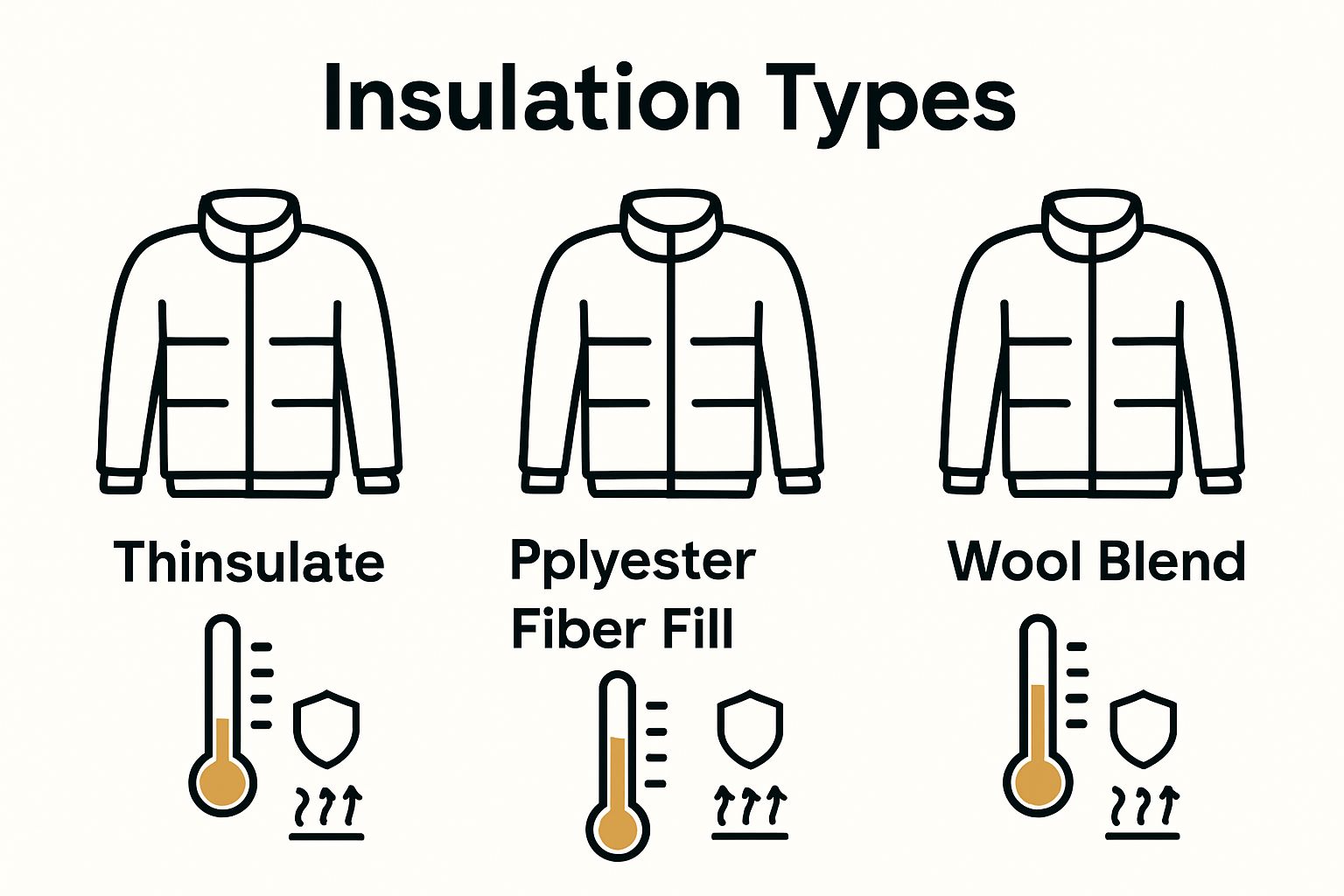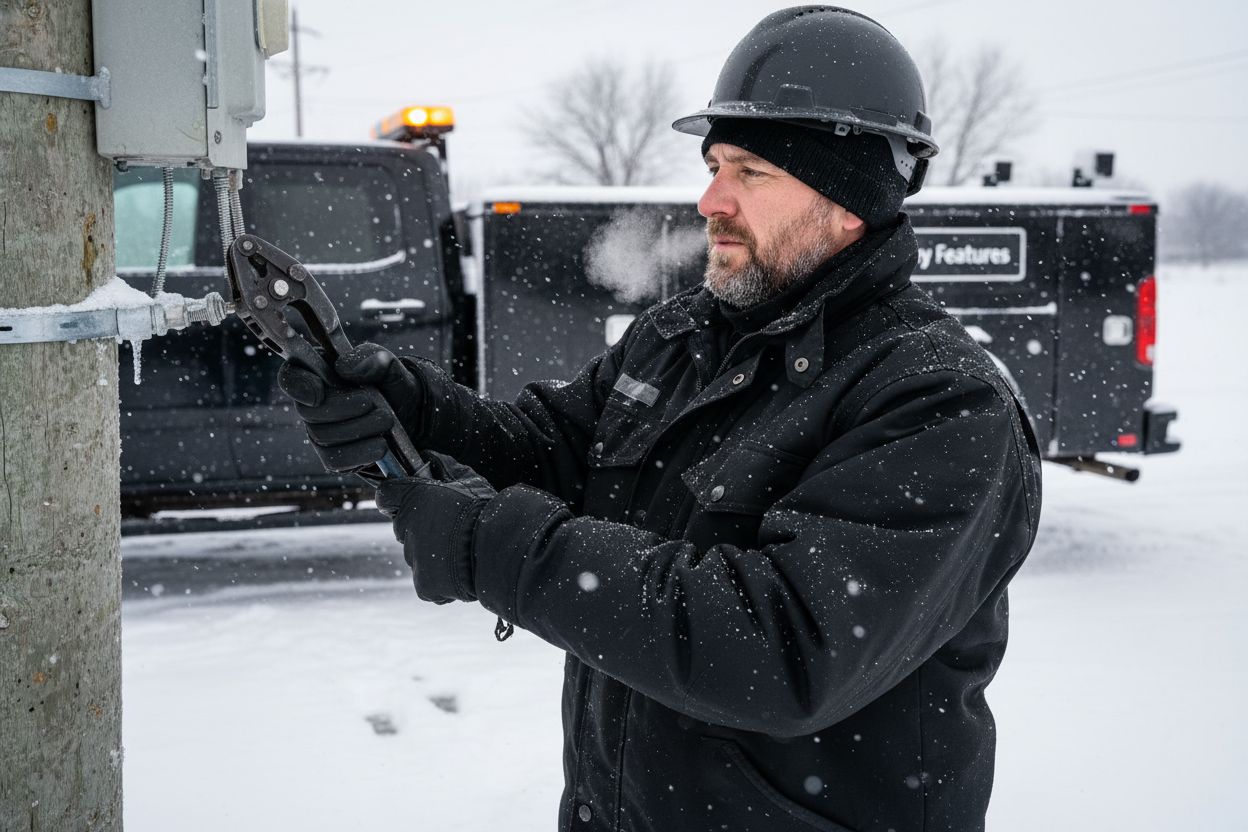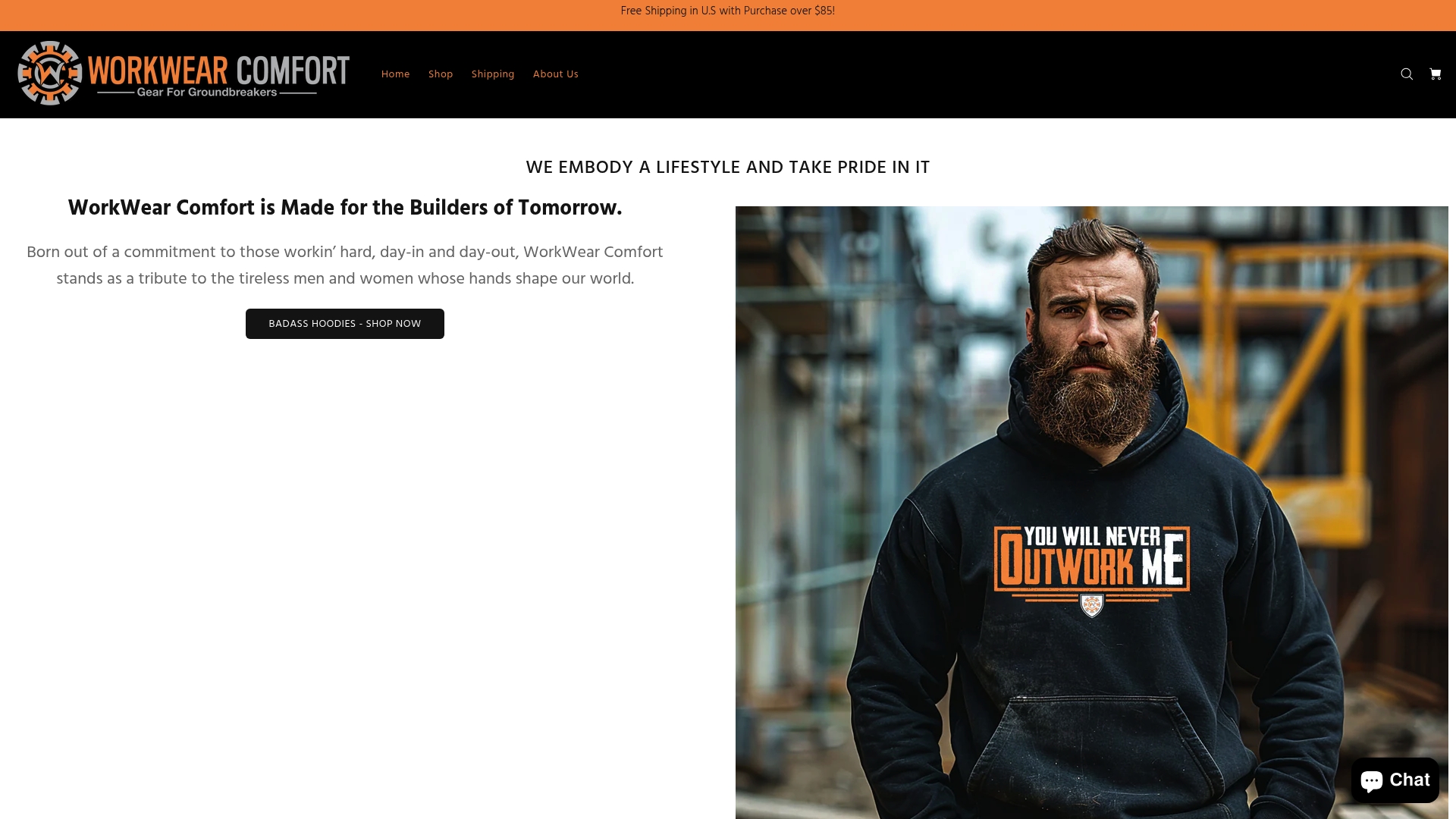Cold weather is more than just a discomfort for workers out on the job. Some industries report that temperature-related injuries and health risks impact thousands every year. Most folks think a thick coat is enough. That idea can leave you shivering and distracted when it matters most. The reality is that true warm work jackets use advanced insulation and smart design so you get both protection and flexibility in the harshest conditions.
Table of Contents
- What Are Warm Work Jackets for Men?
- Why Warm Work Jackets Matter In Various Professions
- Key Features Of Effective Warm Work Jackets
- Materials And Technologies Used In Work Jackets
- Real-World Applications And Choosing The Right Jacket
Quick Summary
| Takeaway | Explanation |
|---|---|
| Proper insulation is essential. | Warm work jackets should use advanced insulation materials to retain body heat effectively and prevent hypothermia. |
| Durability impacts performance. | High-quality materials resist wear and environmental factors, ensuring the jacket performs under challenging conditions. |
| Mobility is a top priority. | Work jackets must allow for full range of motion to enable workers to perform tasks efficiently. |
| Consider job-specific needs. | Different professions require jackets tailored for their specific work environments and associated hazards. |
| Invest in performance and safety. | Choosing the right work jacket enhances worker safety and ensures optimal job performance in cold conditions. |
What Are Warm Work Jackets for Men?
Warm work jackets for men are specialized protective garments designed to shield workers from cold environments while maintaining mobility and functionality. These jackets go beyond standard outerwear by providing robust thermal protection tailored specifically for demanding work conditions.
The Core Purpose of Warm Work Jackets
The fundamental objective of warm work jackets is to protect workers from extreme cold temperatures while allowing unrestricted movement. According to OSHA guidelines on cold stress protection, maintaining proper body temperature is critical for worker safety and productivity in outdoor or refrigerated work environments.
Key characteristics of warm work jackets include:
- Specialized insulation materials that retain body heat
- Durable exterior fabrics resistant to wind and moisture
- Flexible design allowing full range of motion
- Strategic placement of thermal layers for maximum warmth
Construction and Technical Design
These jackets are engineered using advanced textile technologies that prioritize both thermal regulation and durability. Manufacturers typically incorporate multiple layers of synthetic or natural insulating materials like:
- Polyester fiber fill
- Thinsulate
- Wool blend fabrics
- Quilted interior linings
Workers can read more about essential workwear features that enhance comfort and protection in challenging work environments.
Warm work jackets are not merely clothing items but critical personal protective equipment designed to help professionals maintain performance and safety in cold conditions.
By combining advanced materials, ergonomic design, and strategic thermal management, these jackets represent an essential tool for blue-collar workers facing harsh environmental challenges.
Why Warm Work Jackets Matter in Various Professions
Warm work jackets are not just clothing items but critical protective equipment that play a crucial role across multiple professional environments. Different industries require specialized thermal protection to ensure worker safety, productivity, and overall job performance.
Professional Environments Requiring Thermal Protection
Workers in outdoor and extreme temperature environments face significant challenges that demand high-performance thermal wear. According to Bureau of Labor Statistics research, temperature-related workplace injuries and health risks are substantial in industries like construction, agriculture, and transportation.
Key professional sectors where warm work jackets are essential include:
- Construction and infrastructure development
- Agricultural and ranching operations
- Transportation and logistics
- Utility maintenance and repair services
- Emergency response and first responder roles
Performance and Safety Implications
Beyond basic comfort, warm work jackets directly impact worker performance and safety. Proper thermal regulation prevents conditions like hypothermia, reduces muscle stiffness, and maintains cognitive function during prolonged exposure to cold environments. Workers equipped with appropriate thermal protection can maintain dexterity and concentration, which are critical for complex manual tasks.
Professional sectors can explore detailed workwear strategies to optimize worker protection and performance. Warm work jackets represent an investment in human capital, protecting workers while enabling them to perform at their highest potential across challenging work environments.
For quick reference, the table below organizes the different professional environments where warm work jackets are essential, along with the unique risks or demands each setting presents.
| Professional Environment | Risks and Demands Addressed |
|---|---|
| Construction and infrastructure | Prolonged cold exposure, wind, physical range of motion |
| Agricultural/ranching operations | Outdoor temperature swings, moisture from weather and tasks |
| Transportation and logistics | Variable climates, wind chill during transit |
| Utility maintenance/repair | Extended outdoor work, potential exposure to moisture/chemicals |
| Emergency response roles | Rapid response in all weather, need for mobility and warmth |
| Outdoor manual labor | General cold stress, need for durable and flexible protection |
| Refrigerated indoor environments | Constant cold, moisture management, flexibility |
Key Features of Effective Warm Work Jackets
Selecting the right warm work jacket involves understanding the critical features that distinguish high-performance thermal protective wear from standard outerwear. Professional-grade jackets are engineered with sophisticated design elements that go far beyond basic warmth.
Thermal Insulation Technologies
According to NIOSH workplace safety guidelines, effective thermal protection requires strategic layering and advanced insulation materials. Modern warm work jackets utilize cutting-edge insulation technologies that trap body heat while allowing moisture management.

Key insulation technologies include:
- Synthetic fill materials like Thinsulate
- Lightweight polyester fiber insulation
- Wool blend fabrics with natural thermal properties
- Advanced synthetic membrane technologies
Durability and Performance Characteristics
Professional warm work jackets must withstand rigorous workplace conditions. This requires robust construction techniques and materials that provide both thermal protection and long-lasting performance.
To help clarify the key features that make warm work jackets effective, the following table summarizes the most important technical characteristics discussed in the article.
| Feature | Purpose/Benefit |
|---|---|
| Specialized insulation materials | Retain body heat and provide thermal protection |
| Durable exterior fabrics | Resist wind, moisture, and workplace hazards |
| Flexible, ergonomic design | Allow full range of motion for demanding tasks |
| Reinforced stress points/seams | Enhance durability in high-wear areas |
| Water and wind resistance | Shield against harsh outdoor conditions |
| Breathable fabric technologies | Manage moisture and keep workers dry |
| Abrasion-resistant overlays | Protect jacket from damage on job sites |
| Strategic thermal layer placement | Maximize warmth without adding unnecessary bulk |
Critical durability features encompass:
- Reinforced stress points and seams
- Water and wind resistant exterior fabrics
- Abrasion resistant material overlays
- Flexible design allowing full range of motion
Workers can explore comprehensive workwear guidelines to understand how specialized clothing transforms workplace safety and performance. The right warm work jacket is an investment in personal protection, comfort, and professional effectiveness across diverse working environments.

Materials and Technologies Used in Work Jackets
Modern warm work jackets represent a sophisticated fusion of advanced materials and innovative textile technologies designed to provide superior thermal protection and performance. These garments are meticulously engineered to meet the demanding requirements of professional environments.
Synthetic and Natural Insulation Materials
According to industrial safety research, effective work jackets utilize a strategic combination of synthetic and natural insulation materials. These materials are selected for their unique thermal, moisture-wicking, and durability properties.
Key insulation materials include:
- Synthetic polyester fiber fills
- Thinsulate microfiber insulation
- Wool blend fabrics with natural heat retention
- Advanced membrane technologies like Gore Tex
- Recycled synthetic insulation materials
Performance Textile Technologies
Beyond insulation, work jacket materials are engineered with sophisticated performance technologies that enhance functionality. Modern textile innovations focus on creating fabrics that provide thermal regulation, moisture management, and environmental protection.
Critical textile performance characteristics involve:
- Water resistant exterior treatments
- Wind blocking membrane layers
- Breathable fabric technologies
- Quick drying synthetic fibers
- Abrasion resistant surface treatments
Workers can explore comprehensive workwear technology insights to understand how advanced materials transform workplace clothing. The integration of cutting-edge materials represents a significant advancement in protective workwear design, offering professionals unprecedented comfort and performance across diverse working conditions.
Real-World Applications and Choosing the Right Jacket
Selecting the appropriate warm work jacket requires a nuanced understanding of professional environments, specific job demands, and individual performance requirements. The right jacket is not just about warmth but about creating a comprehensive protective solution tailored to unique workplace challenges.
Professional Environment Considerations
According to NIOSH workplace safety guidelines, jacket selection should account for multiple environmental and occupational factors. Different professional sectors demand specialized thermal protection strategies.
Key environmental factors influencing jacket selection include:
- Temperature range and climate conditions
- Duration of outdoor exposure
- Physical activity intensity
- Potential workplace hazards
- Specific industry safety regulations
Matching Jackets to Professional Roles
Each professional sector presents unique challenges that require targeted thermal protection strategies. Construction workers, agricultural professionals, utility maintenance technicians, and emergency responders each need jackets engineered for their specific working conditions.
Critical selection criteria for different professional roles involve:
- Mobility requirements for complex physical tasks
- Compatibility with additional personal protective equipment
- Resistance to specific workplace contaminants
- Thermal regulation during varied activity levels
- Durability under repeated stress conditions
Workers can explore comprehensive workwear selection strategies to understand how specialized clothing transforms workplace performance. Ultimately, the right warm work jacket represents a strategic investment in personal safety, comfort, and professional effectiveness across diverse working environments.
Experience Reliable Warmth and Durability for Real-World Work Conditions
Hard work in cold environments demands more than just average protection. As highlighted in the article, many men face tough challenges like keeping warm without losing mobility and needing jackets that stand up to harsh job sites. If you are tired of gear that lets you down when the temperature drops, it is time to invest in apparel built for real performance. Discover proven solutions from our Blue-Collar Working Man Sweatshirt Hoodies collection, designed specifically for workers who value comfort, resilience, and a strong connection to blue-collar values.

Choose protection and style that meet the demands of your trade. Visit Workwear Comfort to upgrade your work wardrobe with gear that works as hard as you do. Explore our full range of rugged sweatshirts, jackets, and accessories, and make your next cold workday your most comfortable yet. Browse now and take the first step toward lasting comfort and performance.
Frequently Asked Questions
What are warm work jackets for men?
Warm work jackets for men are specialized garments designed to protect workers from cold environments while maintaining mobility and functionality, ensuring safety and comfort in demanding work conditions.
What features should I look for in a warm work jacket?
Key features to look for include specialized insulation materials, durable exterior fabrics resistant to wind and moisture, and a flexible design that allows for a full range of motion.
How do warm work jackets impact worker performance?
Warm work jackets improve worker performance by preventing cold-related conditions, reducing muscle stiffness, and maintaining cognitive function, which helps in performing complex manual tasks effectively.
What materials are commonly used in warm work jackets?
Warm work jackets are typically made from a combination of synthetic materials like polyester fiber fill and Thinsulate, as well as natural options like wool blends, designed to provide insulation, moisture-wicking, and durability.
Recommended
- Best Workwear for Hot Weather: Stay Cool & Protected in 2025 - WorkWear Comfort
- 7 Essential Tips for Choosing the Perfect Hoodie Sweatshirt – WorkWearComfort
- Understanding Sweatshirts: Versatile Apparel Explained – WorkWearComfort
- 7 Essential Features of Hoodies and Jackets for Workers – WorkWearComfort


